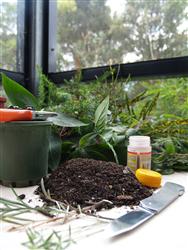 Learn Practical Gardening Skills by Distance Education
Learn Practical Gardening Skills by Distance Education
- One on one tuition from highly qualified horticulturists with decades of hands on experience
- Learning practical skills by distance education does actually work; particularly when you have one on one access with exceptional horticulturists; and the support of our extensive resources.
Course Structure
Eleven lessons as follows:
1. Materials and Equipment
2. Horticultural Calculations
3 Practical Risk Management
4. Machinery and Equipment Assessment and Maintenance
5. Propagation Management
6. Hard Landscape Maintenance
7. Soft Landscape Maintenance
8. Practical Plant Identification Techniques
9. Pest, Disease and Weed Control
10. Identifying plant tissues
11. Planning -identifying needs for management of horticultural sites.
 Duration 100 hours
Duration 100 hours
Aims
- Identify a range of horticultural materials and equipment and sundries
- Specify assessments necessary to perform horticultural operations, and carry out calculations for these assessments
- Assess horticultural situations for risks and hazards, and demonstrate methods and procedures to minimise risk
- Assess the state of repair of a powered implement and carry out routine maintenance or calibration.
- Organise the propagation of a range of plants
- Carry out routine maintenance on a variety of hard landscape features.
- Demonstrate and determine the routine maintenance and future management for production and amenity situations of a variety of soft landscape features.
- Identify a range of seeds and plants
- Identify a range of weeds, plant pests, diseases and disorders, and state methods of their prevention and control.
- Identify plant tissues and state their functions
- Carry out a planning exercise to determine future management of a given area of plants, and all hard or soft landscape features
TIPS FOR MAINTAINING GARDEN TOOLS
The first thing you need to do when undertaking maintenance of your tools is to read any maintenance instructions or manuals supplied with those tools and/or equipment. There may be a regular servicing or maintenance procedure required. When instructions are not supplied then a number of simple maintenance tasks will generally help prolong the life of many power tools.
Looking after your tools is very important. If you look after them then they don't have to be replaced as frequently. Tools in good condition are easier and safer to use. Some simple general reminders are listed below:
• Metal
To prevent rust or corrosion metal either needs painting with a good metal primer, or regular coating with oil (After using, clean and wipe metal parts with an oily rag).
• Sharpening
Keeping your tools sharp usually means less effort is required to use them, so less strain is applied.
• Washing
If tools are kept clean they are less likely to corrode or have moving parts seize. This also reduces the likelihood of pests and diseases being spread from infected areas to uninfected areas.
• Storing
Keeping your tools stored properly means they are less likely to be damaged, lost or stolen. Tools left lying around can also be dangerous, particularly if your business is likely to have young children visiting (i.e. retail nursery), or they can be used by burglars to break into your office, work buildings, or storage sheds.
Power Tool Maintenance
Always read all manuals or leaflets supplied with tools. They may contain very important safety directions. There may be a regular servicing or maintenance procedure required. When instructions are not supplied then a number of simple maintenance tasks will generally help prolong the life of power tools. These include:
1. Make sure all parts of the tool are free of foreign matter or obstructions that may impede the efficient, safe use of that tool. This includes pull-start cords that might be frayed.
2. Make sure that worn or damaged parts are replaced promptly.
3. Make sure that all moving parts are well lubricated.
4. Protect (e.g. paint or wipe with an oily rag) any parts that are likely to rust or become corroded.
5. Keep battery terminals free of corrosion and battery levels topped up. All connections should be kept tight.
6. Make sure any oils are kept topped up, and drained and replaced at regular intervals. Oil filters on machinery should be replaced at regular intervals (follow manufacturers recommendations).
7. Keep air filters clean and unblocked.
8. Keep any cutting edges properly sharpened.
9. Periodically check for and tighten any loose nuts, bolts, screws etc.